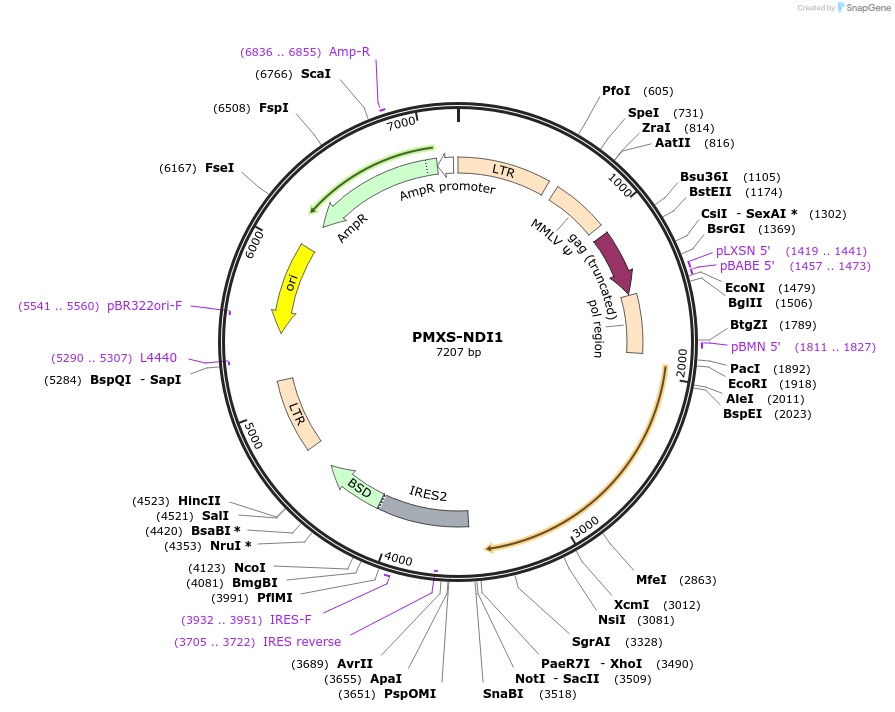-
Purposeexpresses NDI1 in mammalian cells
-
Depositing Lab
-
Sequence Information
Ordering
| Item | Catalog # | Description | Quantity | Price (USD) | |
|---|---|---|---|---|---|
| Plasmid | 72876 | Standard format: Plasmid sent in bacteria as agar stab | 1 | $89 | |
Backbone
-
Vector backbonepMXs-IRES-blasticidin
- Backbone size w/o insert (bp) 5639
- Total vector size (bp) 7181
-
Vector typeMammalian Expression, Retroviral
-
Selectable markersBlasticidin
Growth in Bacteria
-
Bacterial Resistance(s)Ampicillin, 100 μg/mL
-
Growth Temperature30°C
-
Growth Strain(s)NEB Stable
-
Copy numberUnknown
Gene/Insert
-
Gene/Insert nameNDI1
-
SpeciesS. cerevisiae (budding yeast)
-
Insert Size (bp)1542
-
GenBank ID854919 NM_001182483.1
-
Entrez GeneNDI1 (a.k.a. YML120C)
Cloning Information
- Cloning method Restriction Enzyme
- 5′ cloning site EcoR1 (unknown if destroyed)
- 3′ cloning site Xho1 (unknown if destroyed)
- 5′ sequencing primer pLXSN 5' CCCTTGAACCTCCTCGTTCGACC
- (Common Sequencing Primers)
Resource Information
-
Articles Citing this Plasmid
Terms and Licenses
-
Academic/Nonprofit Terms
-
Industry Terms
- Not Available to Industry
Trademarks:
- Zeocin® is an InvivoGen trademark.
Depositor Comments
The retroviral NDI1 vector was generated by cloning into the EcoRI and XhoI sites of the pMXS-ires-blast vector a cDNA insert generated by PCR using the primers below, followed by standard cloning techniques.
Ndi1 EcoRI F: ATGAATTCCATCACATCATCGAATTAC
Ndi1 XhoI R: ATCTCGAGAAAAGGGCATGTTAATTTCATCTATAAT
It is a retroviral plasmid so it may be recommended to be propagated at 30oc but author typically grows it at 37oC.
These plasmids were created by your colleagues. Please acknowledge the Principal Investigator, cite the article in which the plasmids were described, and include Addgene in the Materials and Methods of your future publications.
-
For your Materials & Methods section:
PMXS-NDI1 was a gift from David Sabatini (Addgene plasmid # 72876 ; http://n2t.net/addgene:72876 ; RRID:Addgene_72876) -
For your References section:
Metabolic determinants of cancer cell sensitivity to glucose limitation and biguanides. Birsoy K, Possemato R, Lorbeer FK, Bayraktar EC, Thiru P, Yucel B, Wang T, Chen WW, Clish CB, Sabatini DM. Nature. 2014 Apr 3;508(7494):108-12. doi: 10.1038/nature13110. Epub 2014 Mar 16. 10.1038/nature13110 PubMed 24670634



